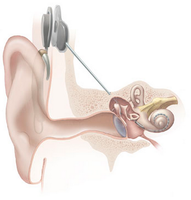








A cochlear implant (CI) is a surgically implanted electronic device that provides a sense of sound to a person who is profoundly deaf or severely hard of hearing.
A cochlear implant is a medical device that is implanted into the head behind the ear of a deaf person. When used with a microphone and speech processor it electrically stimulates the auditory nerve and results in the person being able to hear sound. When the system was first developed in 1978 by Graeme Clark it was referred to as the bionic ear. Since that time a variety of cochlear implants have been developed by the Cochlear division of Nucleus.
Cochlear Limited was founded in Australia in 1981 and, since then, has maintained its position as the international leader in the manufacture and sale of Nucleus® cochlear implant systems.Cochlear implants are designed for use by adults and children who are profoundly or severely deaf and get little or no help from hearing aids.Cochlear's Nucleus implant systems enable hearing impaired people to perceive most environmental sounds and speech. The number of Nucleus® implant recipients worldwide has grown to over 27,000, with more than 13,000 of these being children.
The cochlear implant is an example of innovations in design, combined with engineering, information processing and software design and development.
History
Any history of the cochlear implant must start with an overview of non-surgical treatments proposed in the eighteenth century to overcome the social and psychological consequences of total neonatal deafness. The story begins in the early eighteenth century. Although the Frenchman Abbe de l’Epee (1712-1759) did not actually invent sign language, he did at least bring together the results of various experiences, notably those in Spain, before standardizing and teaching this method with the aim of facilitating communication among all those who practice it, whether deaf or not. Abbe de l’Epee was the first to use sign language to promote the mental development and education of deaf children. In the middle of the eighteenth century he created a free public school, which survived the French Revolution and was perpetuated by the nascent Republic in the form of the National Institute for Deaf-Mutes (Institution nationale des sourds-muets). This institute, now called the National Institute for Young Deaf People (Institution Nationale des Jeunes Sourds), has always been located in rue St Jacques, Paris. For many years it was recognized internationally as a leader in the education of deaf children, but its teachers and physicians disagreed on certain teaching methods: the teachers tended to prefer oralisation (difficult, owing to the lack of sensory feedback), while the physicians (notably Prosper Meniere and Edouard Fournie) opted for sign language. In fact, this disagreement concerned not only communication itself but also the very place of deaf people in society: sign language favored the teaching and development of deaf people within their own community, while oralisation sought to integrate deaf people into the rest of society. Towards the end of the 19th century the development of international transport and the ENT (ear, nose and throat) medical discipline internationalized the debate.
Early cochlear implants in adolescents and adults who had been deaf since birth met with failure, often abandoned by their users. These failures largely accounted for the widespread opposition of the deaf community to this new therapeutic approach. Animal experiments subsequently showed that the auditory system could mature with chronic cochlear implant stimulation,but only if they started to be stimulated within an early period after birth.Early cochlear implantation in children and the corresponding maturational processes ignited in their brains support such concept.